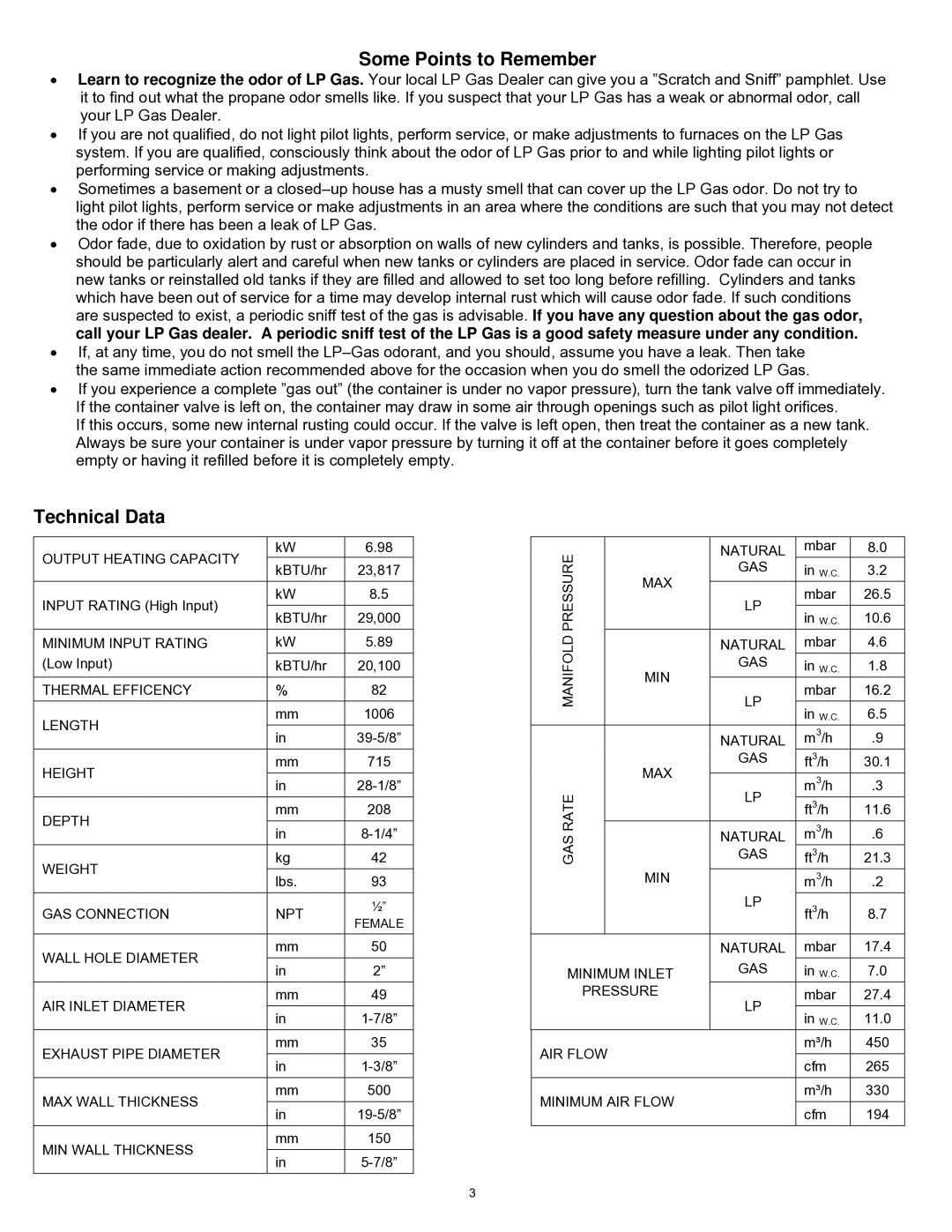Some Points to Remember
•Learn to recognize the odor of LP Gas. Your local LP Gas Dealer can give you a ”Scratch and Sniff” pamphlet. Use it to find out what the propane odor smells like. If you suspect that your LP Gas has a weak or abnormal odor, call your LP Gas Dealer.
•If you are not qualified, do not light pilot lights, perform service, or make adjustments to furnaces on the LP Gas system. If you are qualified, consciously think about the odor of LP Gas prior to and while lighting pilot lights or performing service or making adjustments.
•Sometimes a basement or a
light pilot lights, perform service or make adjustments in an area where the conditions are such that you may not detect the odor if there has been a leak of LP Gas.
•Odor fade, due to oxidation by rust or absorption on walls of new cylinders and tanks, is possible. Therefore, people should be particularly alert and careful when new tanks or cylinders are placed in service. Odor fade can occur in new tanks or reinstalled old tanks if they are filled and allowed to set too long before refilling. Cylinders and tanks which have been out of service for a time may develop internal rust which will cause odor fade. If such conditions are suspected to exist, a periodic sniff test of the gas is advisable. If you have any question about the gas odor, call your LP Gas dealer. A periodic sniff test of the LP Gas is a good safety measure under any condition.
•If, at any time, you do not smell the
the same immediate action recommended above for the occasion when you do smell the odorized LP Gas.
•If you experience a complete ”gas out” (the container is under no vapor pressure), turn the tank valve off immediately. If the container valve is left on, the container may draw in some air through openings such as pilot light orifices.
If this occurs, some new internal rusting could occur. If the valve is left open, then treat the container as a new tank. Always be sure your container is under vapor pressure by turning it off at the container before it goes completely empty or having it refilled before it is completely empty.
Technical Data
OUTPUT HEATING CAPACITY | kW | 6.98 | |
kBTU/hr | 23,817 | ||
| |||
INPUT RATING (High Input) | kW | 8.5 | |
kBTU/hr | 29,000 | ||
| |||
MINIMUM INPUT RATING | kW | 5.89 | |
(Low Input) | kBTU/hr | 20,100 | |
THERMAL EFFICENCY | % | 82 | |
|
|
| |
LENGTH | mm | 1006 | |
in | |||
| |||
|
|
| |
HEIGHT | mm | 715 | |
in | |||
| |||
|
|
| |
DEPTH | mm | 208 | |
in | |||
| |||
WEIGHT | kg | 42 | |
lbs. | 93 | ||
| |||
|
|
| |
GAS CONNECTION | NPT | ½” | |
FEMALE | |||
|
| ||
|
|
| |
WALL HOLE DIAMETER | mm | 50 | |
|
| ||
in | 2” | ||
| |||
AIR INLET DIAMETER | mm | 49 | |
|
| ||
in | |||
| |||
EXHAUST PIPE DIAMETER | mm | 35 | |
|
| ||
in | |||
| |||
MAX WALL THICKNESS | mm | 500 | |
in | |||
| |||
MIN WALL THICKNESS | mm | 150 | |
in | |||
| |||
|
|
|
PRESSURE |
|
| NATURAL | mbar | 8.0 |
| MAX | GAS | in W.C. | 3.2 | |
| LP | mbar | 26.5 | ||
|
| ||||
|
| in W.C. | 10.6 | ||
|
|
| |||
MANIFOLD |
|
| NATURAL | mbar | 4.6 |
| MIN | GAS | in W.C. | 1.8 | |
| LP | mbar | 16.2 | ||
|
| ||||
|
|
|
| ||
|
| in W.C. | 6.5 | ||
|
|
|
| ||
|
|
| NATURAL | m3/h | .9 |
|
| MAX | GAS | ft3/h | 30.1 |
RATE |
| LP | m3/h | .3 | |
|
| ||||
|
| ft3/h | 11.6 | ||
|
|
| |||
|
| NATURAL | m3/h | .6 | |
GAS |
|
| GAS |
|
|
|
| ft3/h | 21.3 | ||
|
| MIN |
| m3/h | .2 |
|
|
| LP | ft3/h | 8.7 |
|
|
|
| ||
|
|
|
|
|
|
|
|
| NATURAL | mbar | 17.4 |
MINIMUM INLET | GAS | in W.C. | 7.0 | ||
| PRESSURE | LP | mbar | 27.4 | |
|
|
|
|
| |
|
|
| in W.C. | 11.0 | |
|
|
|
| ||
AIR FLOW |
| m³/h | 450 | ||
|
|
| |||
| cfm | 265 | |||
|
|
|
| ||
MINIMUM AIR FLOW |
| m³/h | 330 | ||
| cfm | 194 | |||
|
|
|
| ||
3
